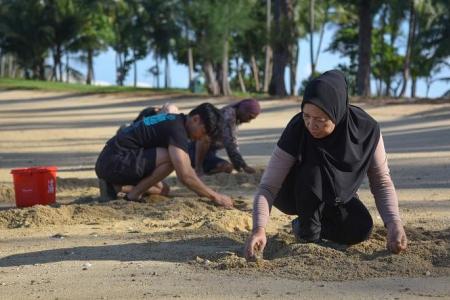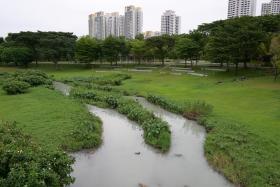Singapore’s urban and island foragers find food in the wild
In a country governed by appetite, it is a delicious irony to find food hiding in plain sight.
All over Singapore – in common grass patches, roadside trees and sandy beaches – edible life flourishes, unnoticed by most. Only local foragers are exempt from ignorance.
Foraging – the ancient practice of gathering useful flora and fauna for food, medicine or other art – is enjoying a quiet renaissance, though it remains a fringe interest.
Foraging guide and director of permaculture firm CarbonInQ Alexius Yeo, 39, logged a two-fold increase in sign-ups for his foraging class post-pandemic, even with stiffer competition as more guides have emerged.
Nature’s covert store is hardly “exotic”, he said. Its deep roots in the region extend to a pre-metropolitan Singapore, when Malays foraged for food, with a fondness for ulam (a raw salad), and the Chinese scavenged for medicine, prizing the leaves of the cat whisker plant, he added.
As a rule, the author of 101 Edible Plants prefers to meet his class wherever they are, if only to show them that food is literally growing at their doorstep.
Sometimes, this means taking white-collar clients to the grass field outside their office building or a school group for a walk around their campus. Mostly, they find weeds - pest plants believed to be the enemy of crops.
Of the 101 plants itemised in his local catalogue, Mr Yeo’s favourites are the most ubiquitous weeds: lavender sorrel, the wild pepper plant and the gunpowder plant, which are found “easily everywhere”, he said.
“That’s what fascinates people most, the weeds,” he said, “because they recognise them and say they hate them but after learning they can be eaten or used for healing, they get excited.”
Another urban forager, Mr Esmonde Luo, 36, said more diverse groups are beginning to approach him for his $80-a-pop tours, including chefs, students and office workers.
More visibly, Chef De Partie at Bottega di Carna, Ian Tan, 27, bagged the World Young Chef award in 2023 with a garnish of foraged ginger flowers and wild pepper leaves — the former providing a “gentle tartness” that could not be bought in stores, he said.
The work of a forager is often solitary – by design, Mr Yeo and Mr Luo say, after upwards of 10 years in the scene without ever crossing paths. Still, both guides say the sudden tide of interest stem from a concern with food security.
The pandemic exposed the fragility of the supply chain, said Mr Luo, “freaking people out” and driving a turn towards the local bounty.
But if fear of an empty larder has awakened a desire to live off the land, it has not translated into any significant changes in foragers’ diets, who estimate that no more than 10 per cent of their meals are foraged. Neither did food scarcity or its threat push the self-taught Mr Luo into practice a decade ago. Other appetites were at play.
What hooked him was curiosity.
During a routine stroll at Hort Park, the full-time landscaper noticed that certain weeds bore uncanny resemblance to the plants grown in the garden lots; “Could they be eaten too?” he wondered.
He began investigating, identifying new plants from scientific books and then administering an “edibility test” by touching the unfamiliar plant to increasingly sensitive areas of his body to check for adverse reactions. Finally, he would pop it into his mouth, raw.
The results were and still are dutifully recorded in his field notes.
“It’s a lot of trial and error,” he said, while cautioning that most edible plants taste awful raw. It can be dangerous, too.
Years ago, he boiled wild yam to neutralise its numbing effect only to have it sear his mouth with “pins and needles”, he said. The “poison” was mild but he had to stop eating.
The risk and reward are part of the fun, said Mr Luo, whose biggest success has been fermenting the “unbearably sour” rukam masam fruit into a delicious wine, which his friends say tastes like umeshu, a Japanese liquer.
“It’s fascinating to turn the nasty into the tasty,” he said.
For him, the pleasure of discovery is at the heart of his quest. “Adventurous people are always looking for new things to touch and transform. That’s what foraged food represents to me - new frontiers, new possibilities in tiny Singapore,” he said.
But the novelty of urban foraging is only half the picture in Singapore, where former islanders and their descendants practise a saltier, much older form: coastal foraging.
Nenek moyangku adalah pelaut (My ancestors were sailors)
For this group, who take from the sea, foraging is less a hobby than an act of cultural retrieval, a way of evoking a lost way of life after their families were resettled to the mainland in the 1970s.
As he watched his mother, uncle and brother, all hailing from Pulau Semakau, pick molluscs from the waters off Pulau Hantu, the founder of Orang Laut SG Firdaus Sani, 35, told The Straits Times: “This is embedded in our day-to-day lives. Islanders needed to forage to survive.”
Mother and son stood stooped in the shallow water of an islet, scanning the sea for the flash of pink and stripe of green, typical of the siput ranga’s shell, the sudden white of the gong gong jantan and the fat orange flesh of the siput kilah, all staples of a bygone diet, when supermarkets were a boat ride away.
Though they no longer forage for subsistence, Mr Firdaus said the practice is essential to his family life and is the chief means by which wisdom is passed down. “I learn everything from my mother.”
For the people of the sea, or the Orang Laut, the foraging know-how runs much deeper than what is edible and how to prepare it. There is the tricky business of telling the weather, reading the tides from the sharpness of waves, finding the direction of the wind - “a north wind is best for fishing” - and mastering the sea-walk, a way of gliding one’s feet on the seabed so as not to spook lurking stone fish that may retaliate with a venomous sting.
There is an etiquette to it, too; for the sea is a guardian, with its own set of rules, said Mr Firdaus.
As a child, Mr Firdaus was once so absorbed in gathering clams from the beach, that his family drove off without him. “I was caught up in the heat of the moment,” he said, “and ended up crying on the beach alone.” It was an early lesson against greed.
Three decades later, he would instruct the ST team accompanying him to return all small clams raked from the beach. “We never take the babies and we never take more than we need,” he said.
Another rule: “Everything we take must have a purpose.”
“What is the joy of foraging? It’s a heavy question for me because so much of Singapore’s native history has been erased. People don’t know the Malay names for islands. Foraging is the only thing that can remind us of our past that we are still able to do today,” he added.
Mr Firdaus has a word of advice for those considering a go at the ancient practice. “Foraging is not for everybody. It’s okay to learn, see how cultures do it, but whether you want to start… that should be given more thought.”
Get The New Paper on your phone with the free TNP app. Download from the Apple App Store or Google Play Store now


